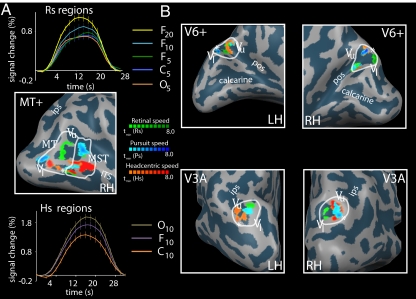Fig. 3.
Rs, Hs, and Ps sensitivities in MT, MST, V3A, and V6+ in one representative subject. ROIs are identified by white borders. For MT, V3A, and V6+, the vertical upper (Vu) and vertical lower (Vl) meridians of the polar angle map are depicted, as is the foveal part (asterisk) of the eccentricity map (ITS, inferior temporal sulcus; POS, parietooccipital sulcus; IPS, intraparietal sulcus). (A) Identified Rs, Ps, and Hs-sensitive regions within MT and MST [Middle: tmin(Rs) = 3.0, tmin(Ps) = 2.5; tmin(Hs) = 6.0]. The average BOLD response over all voxels within the Rs-sensitive regions (Top) shows a clear response increment for increasing retinal speed levels (subscripts) in FIXATION, but lacks an amplitude difference for OPPONENT versus CONSISTENT at the same pursuit and retinal speed level. The average BOLD response across all voxels within the Hs regions (Bottom) shows a clear amplitude difference between the opponent (Hs, 20 °/s) and consistent (Hs, 0 °/s) condition at the same pursuit and retinal speed level. (B) Identified Rs-, Ps-, and Hs-sensitive regions within V3A [Bottom: right hemisphere, tmin(Rs, Ps, Hs) = (2.7, 3.3, 6.0); left hemisphere, tmin (Rs, Ps, Hs) = (2.8, 2.7, 4.0)] and V6 (Top: right hemisphere, tmin (Rs, Ps, Hs) = (4.0, 5.5, 6.0); left hemisphere, tmin (Rs, Ps, Hs) = (4.2, 4.1, 3.0)].

